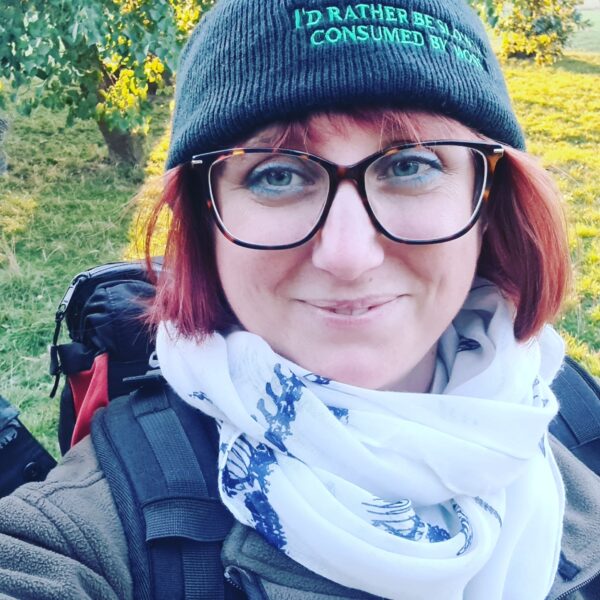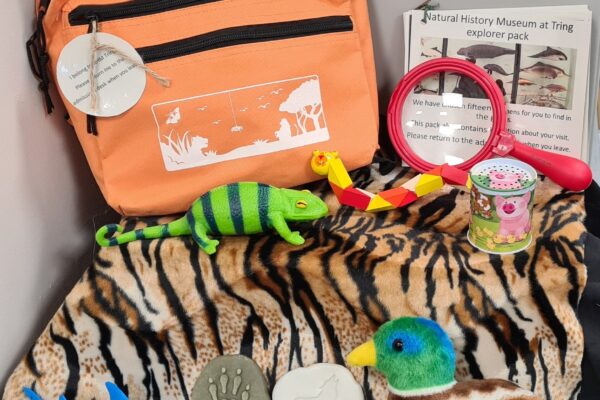
By Joanna Durant, Natural History Museum Tring
Over the past few months we have been developing our sensory packs for visitors to the Natural History Museum at Tring (the sister site to the museum in South Kensington). Our museum is a collection of Victorian taxidermy with over 4,000 specimens on display in large glass and mahogany cases. It was set up in 1889 by Walter Rothschild, who was an avid collector of animal specimens and a keen naturalist, and was opened to the public in 1892.
In 2019 the Learning and Events team at the museum decided that our access offer needed looking at, so we began to plan and take forward some ideas. Unfortunately, as with many museums and galleries, these plans were put on hold in 2020. We are now able to re-evaluate our offer and develop and deliver our initial plans.
We have two types of packs to improve access – our Explorer rucksacks, which were initially put together a few years ago for children with sensory processing needs such as autism, and our newly developed Tactile bags for blind and partially sighted children.
Our Explorer rucksacks are freely available for visitors to borrow if they have a child in their group with autism, learning difficulties and sensory processing needs. They are also used by school groups if a child is struggling to process or concentrate during a school session, or if they require some extra tactile material during their visit to the galleries.
The rucksacks include animal-based fidget toys, faux fur and a magnifying glass. We sourced these from a variety of places – some things we had in our Learning and Events resources already, so we went through materials and toys that we thought would be suitable. Others we found on websites such as Etsy, Sensory direct and Cheap disability aids.
We have also just produced an Explorer pack booklet, which includes information about the museum from an access point of view (including warnings about the hand-dryers, which some children find distressing). It also features photos of 15 of our favourite specimens to help give children a focus in the galleries if they need one.
Unfortunately, last year we had a theft of all 5 of our Explorer bags, which used to be given out at our Admissions desk upon request by our staff with a friendly reminder to drop them back after use. This left us questioning how our procedure could be improved and we decided to produce a simple form that is kept at our Admissions desk and is used by our staff to keep tabs on the new bags. The form simply asks for a name, email and contact number and states that this data will not be used for any other purposes – upon return of the bags these forms are destroyed. Our staff are always available to answer any questions as the bags are given out and returned.
We have recently developed a set of rucksacks for blind and partially sighted children. Each rucksack contains a pack for each of our galleries, and includes tactile resources and a set of prompting questions and activities to encourage engagement throughout the museum. The development of these rucksacks is a work in progress – to gain some initial ideas we walked around each gallery and jotted down some key groups of animals or specimens that feature in that particular room, to ensure that each pack was relevant to its gallery. We then formulated some fun questions and activities and descriptions of the pack’s resources and produced a large-print booklet for each pack. The resources range from ammonite fossils to animal toys and faux and real fur. We are planning on trialling these rucksacks on our first “Tactile explorers” morning, a new initiative that invites blind and partially sighted children and their adults to get up close to real specimens.

As well as these free resources to support visitors, we also run a free session for SEND school groups called Walters world adventure, which uses our different senses to explore the places that Walter Rothschild visited and his collection of favourite animals. This hour long session can be tailored to the needs of the group and is very student-led depending on their interests and ability levels, while still teaching them about how we can use our senses to explore the world around us. We also provide free Makaton gallery trails on our website, which can be printed off for free and used by groups as self-guided aids during their visit to the museum. Link to SEND pages on museum’s website
We also run a quarterly event that is always very popular called SENDsational mornings, a free, pre-booked event for children with SEND and their families. We only open the museum to ticket holders during these events, which we make clear on our website and social media. The event runs from 10 – 12 on a Sunday, and from 12 the general public are able to enter the museum, so our staff ensure that all ticket holders still in the building are aware that the place will get busier and noisier.
During these events we turn off hand dryers, projections and any background gallery music and videos. We set up one of our rooms as a sensory space with dimmed lighting, blankets, cushions, cuddly toys and sensory lights. We have a handling table of around 10 specimens relevant to the theme that people can touch if they want to, along with some fact cards and other resources such as large maps. We also have a craft activity which people can sit down and take part in if they wish to. Feedback on these events is always positive and people often travel quite a way to visit.
All of these initiatives to improve access and inclusion are being constantly tweaked as we receive feedback and visitor comments, so it is a very organic process. As staff members we are constantly learning ourselves too, in the hope that our museum provides a welcoming, educational and fun experience for everyone.


